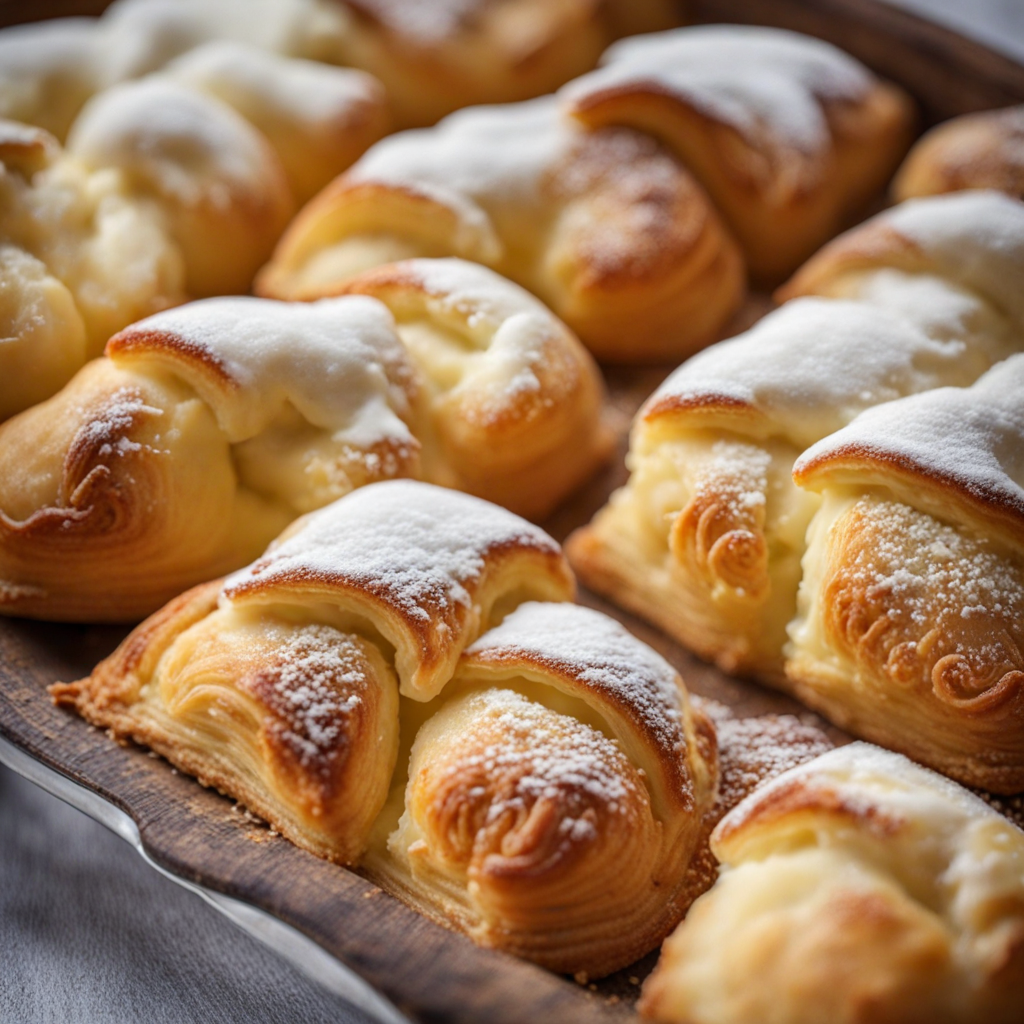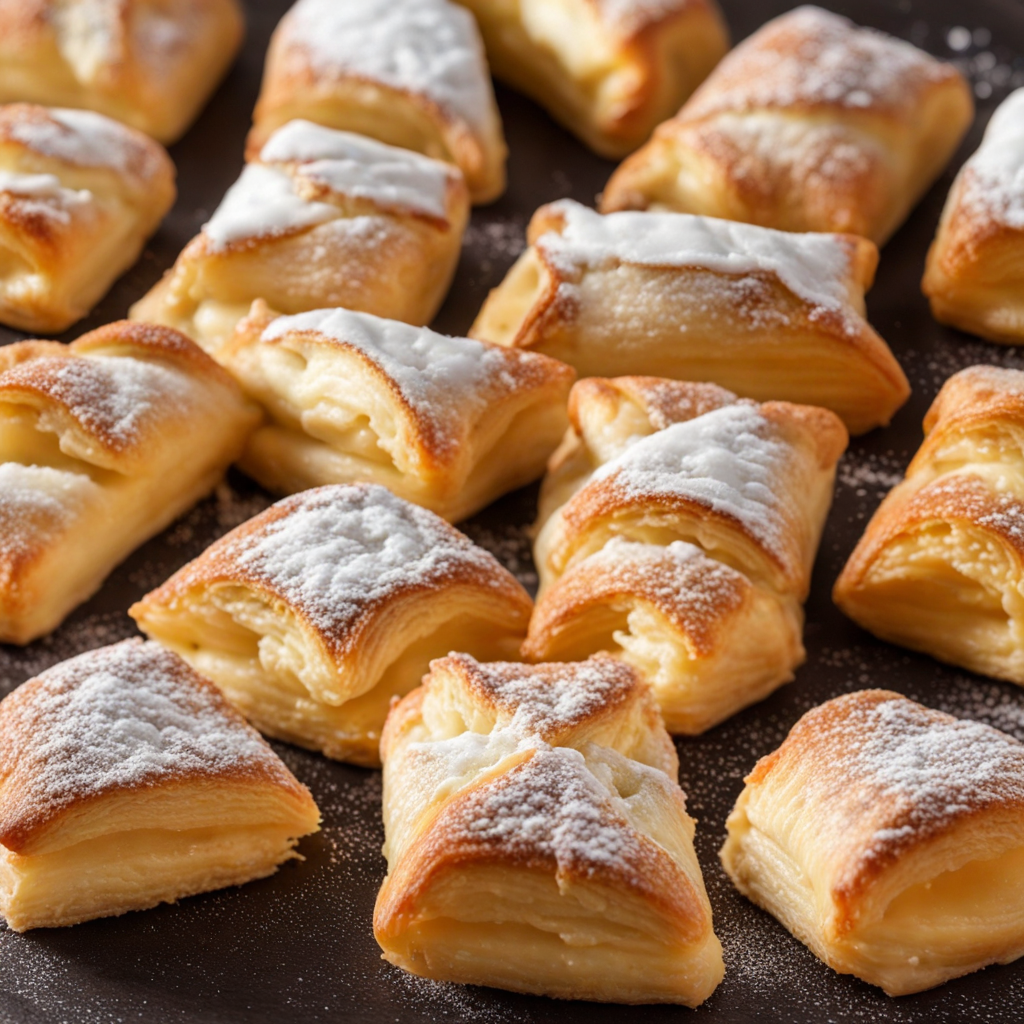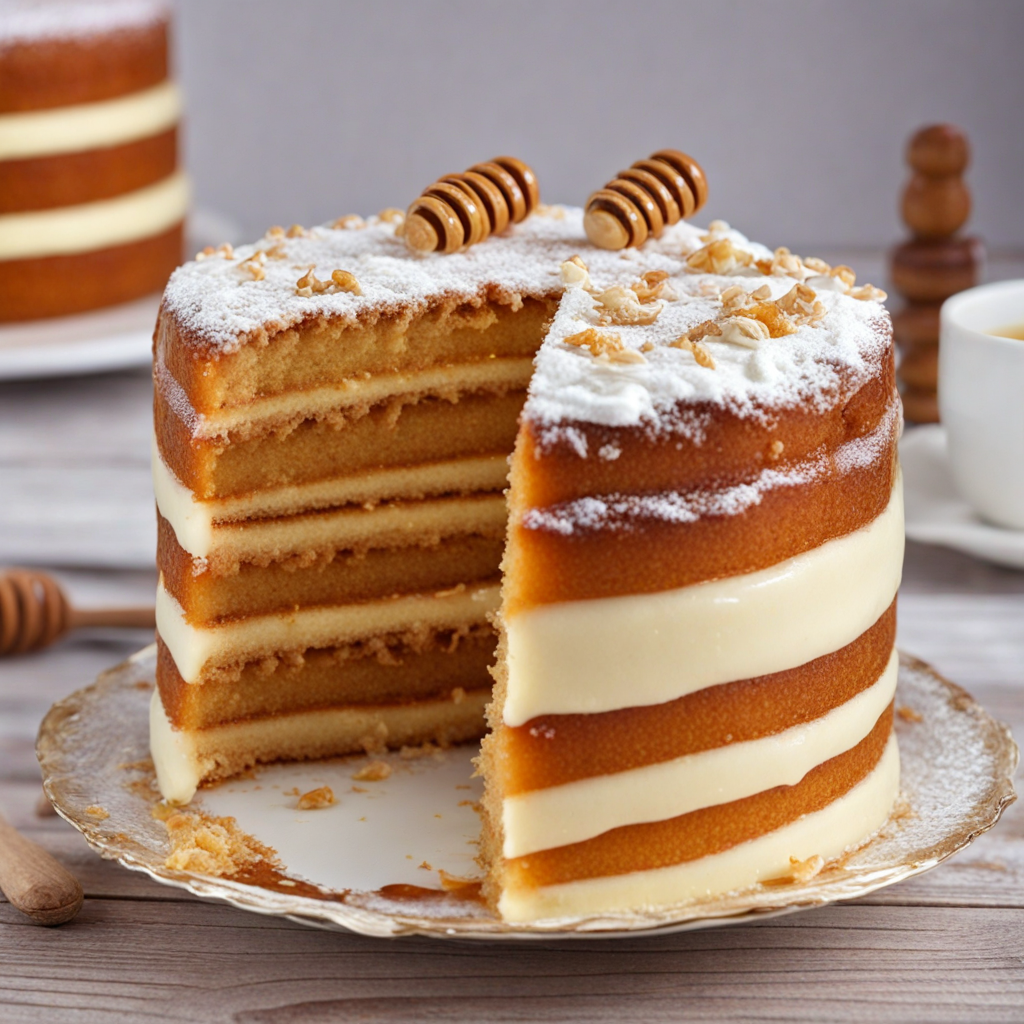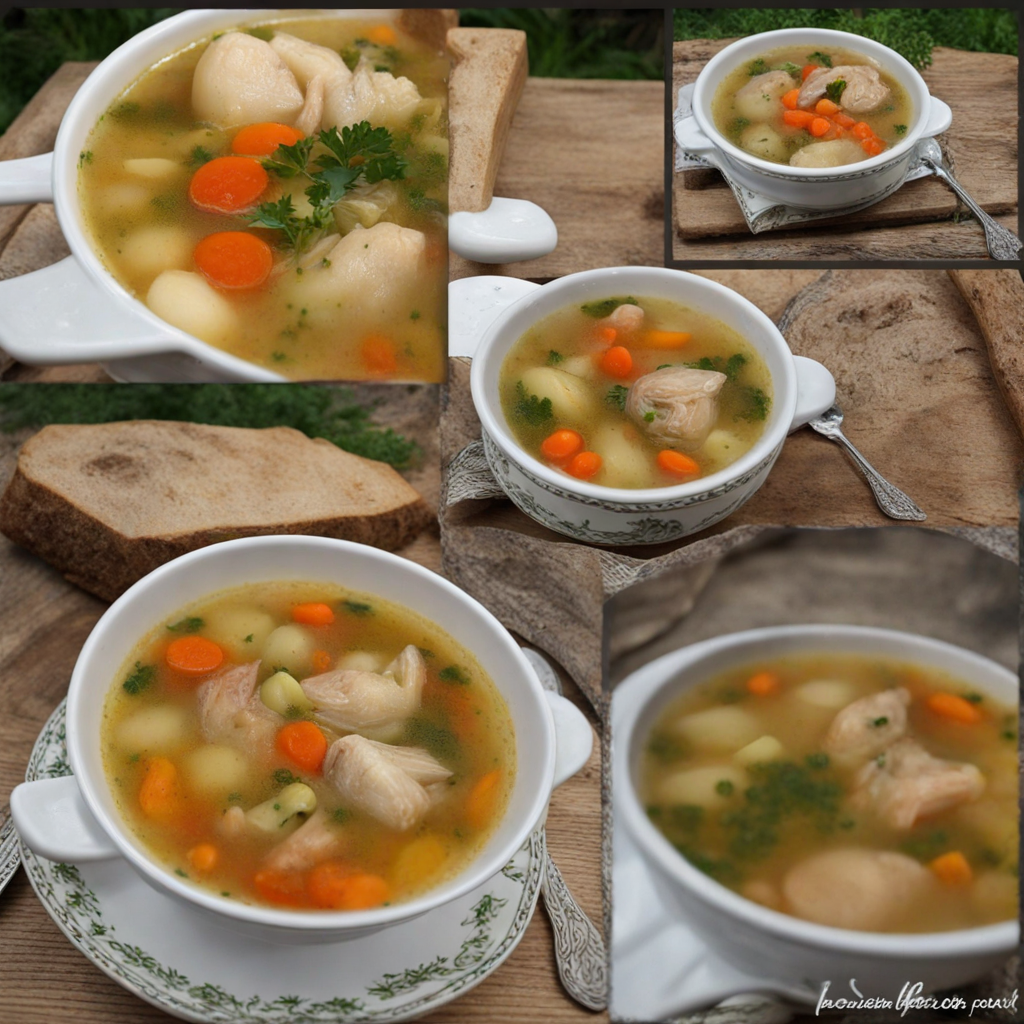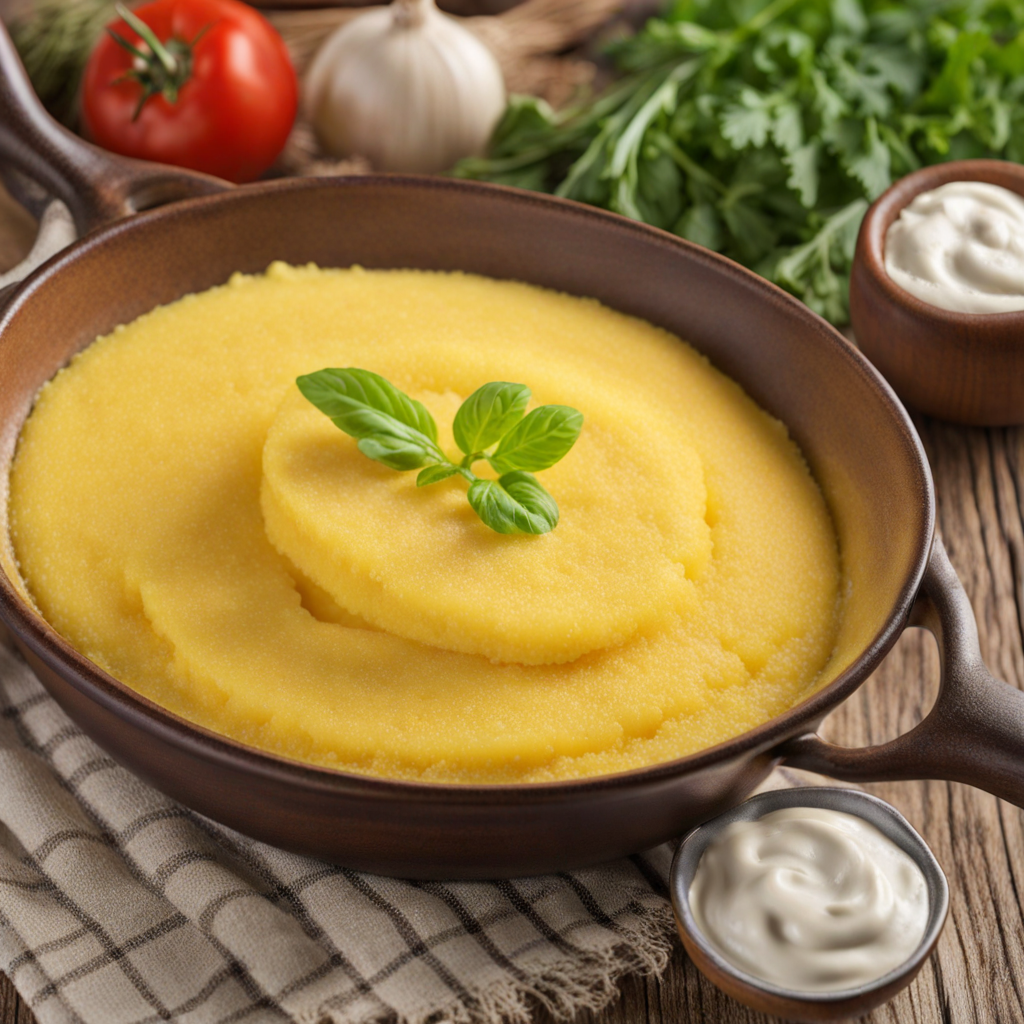Sweet Cheese Pastries
Sweet Cheese Pastries, known as "Brânzoaice" in Romania, are delightful treats that showcase the country’s rich culinary tradition. These pastries are typically made with a flaky, buttery dough that envelopes a creamy, sweet cheese filling. The cheese used is often a blend of ricotta or a local variant called "telemea," which gives the pastries a unique flavor profile. The dough is rolled out thinly, filled generously with the sweet cheese mixture, and then folded or rolled into various shapes before baking to golden perfection. The aroma of these pastries wafting through the air is simply irresistible, enticing anyone nearby to indulge in their sweet allure. The filling of Sweet Cheese Pastries is what truly sets them apart. Often sweetened with sugar and flavored with a hint of vanilla or lemon zest, the cheese filling strikes a delightful balance between creamy and tangy. Some variations may include raisins or other dried fruits, adding a chewy texture and a burst of flavor that complements the smoothness of the cheese. As you take a bite, the contrasting textures of the flaky pastry and the rich filling create a delightful mouthfeel that is both comforting and satisfying. These pastries are typically enjoyed as a sweet snack or dessert, making them a popular choice for breakfast or afternoon tea in Romania. Often dusted with powdered sugar or served with a side of fruit preserves, Sweet Cheese Pastries offer a perfect balance of sweetness and richness. They embody the essence of Romanian comfort food, providing a warm, indulgent experience that invites you to savor every bite. Whether enjoyed fresh from the oven or at room temperature, these pastries are a must-try for anyone looking to explore the delightful world of Romanian cuisine.
How It Became This Dish
The Enigmatic Journey of Poale-n Brâu: A Romanian Culinary Treasure #### Origins and Early History Poale-n brâu, often translated as "folded in the apron," is a traditional Romanian pastry that holds a special place in the hearts and homes of the Romanian people. Its origins can be traced back to the historical regions of Moldova and Transylvania, where it is believed to have evolved from a blend of local peasant traditions and influences from neighboring cultures, including Hungarian and Slavic culinary practices. The dough used for Poale-n brâu is typically a yeasted pastry, which is a common feature in many Eastern European baked goods. The filling often consists of a mixture of sweet cheese, eggs, and sometimes raisins or sour cream, reflecting the agrarian lifestyle of the regions where it originated. The use of dairy, particularly cheese, is significant in Romanian cuisine, symbolizing the pastoral heritage of the country. #### Cultural Significance The significance of Poale-n brâu goes beyond its delicious taste; it represents the communal spirit and agricultural traditions of Romania. Traditionally, this dish was made for festive occasions, such as weddings, holidays, and family gatherings. It was often prepared by women who would gather in the kitchen, sharing stories and laughter as they worked together to create this beloved treat. The name “Poale-n brâu” itself evokes images of rural life, where women would often carry their aprons filled with food. This metaphorical connection to the apron symbolizes hospitality and nurturing, central tenets of Romanian culture. The act of sharing food is deeply ingrained in Romanian social customs, and Poale-n brâu serves as a perfect example of how food can foster connection and community. #### Evolution Through Time As Romania underwent various historical changes, including the impacts of the Ottoman Empire, Austro-Hungarian Empire, and later Soviet influence, the recipe and preparation of Poale-n brâu adapted over time. During the 19th century, with the rise of nationalism and the romanticization of folk traditions, there was a renewed interest in traditional Romanian dishes, including Poale-n brâu. Cookbooks began to be published, and recipes were passed down through generations, often varying slightly in ingredients and methods based on regional preferences. In Transylvania, for example, Poale-n brâu is sometimes made with a thicker cheese filling, while in Moldova, the dough might be lighter and flakier. This regional diversity adds to the richness of the dish and showcases the localized agricultural products that influenced its preparation. Moreover, as urbanization increased in the 20th century, many families moved away from rural areas, leading to changes in how traditional dishes were prepared. Poale-n brâu began to appear in bakeries and restaurants, making it more accessible to a wider audience. #### Modern Adaptations and Global Influence In contemporary Romania, Poale-n brâu has experienced a renaissance as both a nostalgic comfort food and a gourmet dish. Modern chefs have begun to experiment with the classic recipe, introducing new flavors and techniques while respecting the dish's traditional roots. Some variations now include different types of cheese, such as feta or ricotta, and additional ingredients like herbs or spices, showcasing the versatility of this beloved pastry. Furthermore, the globalization of food culture has led to an increased interest in Romanian cuisine internationally. As diasporic communities spread across the globe, they brought their culinary traditions with them, including Poale-n brâu. Romanian expatriates have established restaurants that serve traditional dishes, helping to preserve their culinary heritage while introducing it to new audiences. Poale-n brâu can now be found in Romanian festivals and cultural events around the world, where it is celebrated not just as a food but as a symbol of identity and belonging. #### The Art of Making Poale-n Brâu The preparation of Poale-n brâu is an art form that involves patience and skill. The dough is typically made from flour, yeast, milk, and eggs, creating a rich, pliable base. The filling, often a blend of cow's cheese or sheep's cheese, sugar, and eggs, is mixed until smooth. Some recipes call for the addition of sour cream or even vanilla for a hint of sweetness. Once the dough has risen, it is rolled out and cut into circles. A spoonful of the cheese filling is placed in the center of each circle, and the edges are carefully folded over, creating a half-moon shape. The pastries are then baked until golden brown, resulting in a flaky exterior that encases the creamy, sweet filling. In many Romanian households, making Poale-n brâu is a cherished family tradition. Grandmothers often pass down their secrets to their grandchildren, ensuring that the techniques and flavors remain intact. This generational passage not only preserves the recipe but also strengthens familial bonds, as cooking together becomes a shared experience. #### Conclusion Poale-n brâu is more than just a pastry; it is a reflection of Romanian tradition, community, and history. Its journey from rural kitchens to urban bakeries and international tables tells a story of resilience and adaptability. As it continues to evolve, Poale-n brâu remains a symbol of the warmth and hospitality that characterize Romanian culture. Whether enjoyed at a family gathering, a festival, or a restaurant, this delicious dish bridges the gap between past and present, reminding us of the importance of food in connecting us to our roots and to each other. In a world that is constantly changing, Poale-n brâu stands as a testament to the power of tradition, proving that some recipes are worth preserving—one delicious bite at a time.
You may like
Discover local flavors from Romania


